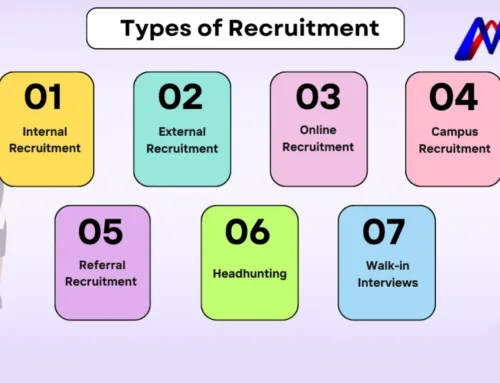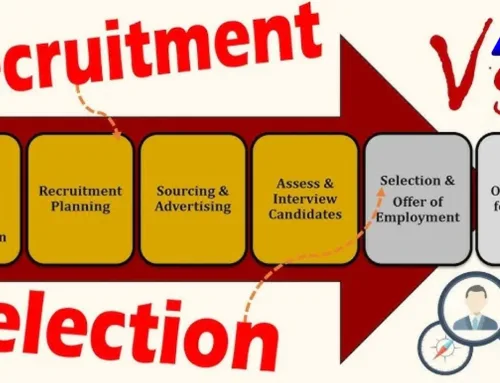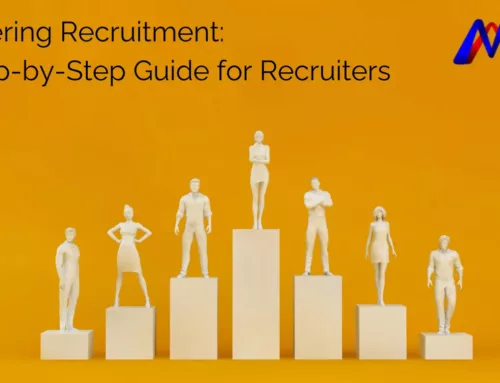Recruitment is a crucial aspect of building a successful team. Whether you are a small business owner or a manager in a larger organization, finding and attracting the right talent is essential for driving growth and achieving your goals. In this blog post, we will explore the intricacies of recruitment, uncover effective strategies to attract top candidates, and delve into the importance of creating a seamless hiring process. Join us as we navigate the world of recruitment and discover how it can positively impact your organization’s success.
As candidates are now more informed than ever, businesses must respect their time during interviews to ensure they feel free and leave their business with a favorable impression.
Companies looking to attract diverse candidates need to build an employer brand that values diversity and encourages employees to discuss it – this will enable them to recruit more successfully.
Contact Us
Definition of Recruitment And Selection
Recruitment is recruiting the appropriate people for your organization, from advertising vacancies to onboarding new employees. Recruitment is an integral component of business success; getting it right can save your company thousands in lost productivity and training expenses; it is critical to invest in an extensive recruitment strategy focused on quality over quantity.
Professional recruitment agencies are an invaluable asset when it comes to recruitment. They can help your organization find top talent quickly while saving you time by screening and assessing them themselves. Furthermore, pre-employment assessments explicitly designed to be impartial can reduce unconscious bias risks significantly.
Recruitment agencies can use Boolean search techniques to refine their searches and quickly find more suitable candidates. This technique works by filtering keywords in online job boards and candidate databases. While Boolean searching techniques may provide effective candidate searches, recruitment should always be distinct from selection – selection involves formalizing contracts between all parties involved to form contractual relationships that benefit everyone involved in the hiring process.
Though recruitment and selection processes may appear straightforward, achieving success requires a comprehensive understanding of organizational needs and talent requirements. This can be accomplished via employee surveys, focus groups, interviews with department heads and hiring managers, or any combination. By employing these methods, you can build an employee pipeline that supports both short-term and long-term goals for talent acquisition.
Process of Recruitment
Recruitment processes are an effective means of recruiting talent into a business. Beginning with writing an accurate job description that clearly states its goals and responsibilities and ending with selecting candidates to hire, recruitment processes can help avoid high turnover rates or poor performance among staff members, both internal and external candidates alike.
You must know your audience and their needs to recruit the ideal candidates effectively. For entry-level employees, offering a training program or internship could be particularly effective at finding qualified individuals quickly and starting them off within your company.
Advertise open roles on job boards, social media, and career websites to reach potential candidates and attract talent. Be sure to provide all pertinent details about your part – qualifications required and skills the candidate must possess – in a concise ad that captures its essence.
Once you’ve collected applications, the next step should be screening and interviewing candidates to find those with whom you will work best. By using behavioral questions and assessment techniques to gain more information on each individual beyond what can be found on their resume or application forms, you’ll gain a clearer picture of their personality, motivations, and whether or not they would make good additions to your team.
If you decide to extend an offer, ensure compensation is discussed during this stage. Include salary, performance bonus, perks, and other benefits to close the deal successfully. In addition, provide communication between applicants throughout the hiring process to maintain transparency and fairness.
Selection Process
An effective recruitment and selection process enables companies to quickly attract a large pool of candidates before narrowing them down until finding their ideal match for every role. Adopting this method saves both time and money while decreasing absenteeism and turnover rates and creating an efficient workforce.
Recruiters must consider how candidates fit into an organization’s culture and best serve customers. To do so, recruiters should identify essential qualifications for each position before using various screening techniques to sift applicants and choose suitable ones; such steps might include telephone screening interviews, job-related tests, or behavioral interview questions that enable recruiters to assess candidates’ personality, communication skills, and work habits.
Once the initial screening has been completed, it’s essential to conduct extensive reference checks. Depending on the nature of the job, this could involve asking references about their ability to complete specific tasks, leadership, and managerial abilities, and whether they possess all the necessary skills needed for their field of employment. Furthermore, reference checks can help recruiters detect any red flags, such as poor attitudes or past drug abuse histories, that should raise red flags with recruiters.
At this point, conducting medical exams on potential candidates is also wise. This step can be crucial for roles that require heavy physical work or travel; health assessments provide invaluable information about fitness levels that could reduce employee absenteeism and injuries.
Finalizing the selection process means making an offer to the successful applicant and giving your company an opportunity to discuss salary, bonuses, and working hours before beginning their new careers with you.
Tips for building your team
Recruitment can be complex, so selecting the appropriate people for your team is critical to its success. An experienced group will understand each role’s specific requirements and can quickly sell candidates on your opportunity. In addition, having individuals who think like marketers is crucial in creating engaging job descriptions and employer brands that attract top talent.
As part of your team selection process, one key consideration should be familiarity with HR and recruitment trends. With recruitment technology constantly evolving and employers focusing more on diversity hiring than in years past, your team must stay current. For instance, cultural fit should always be considered when assessing candidates. Furthermore, keeping up with recruitment tech changes improves efficiency and higher-quality hires.
Ensure your recruiting team has access to tools and technologies they need for efficient performance, like software that automates interviews. Sonru allows candidates to record answers to customized questions before returning them later. This type of recruitment technology is beneficial in recruiting distant candidates or those difficult to reach due to schedule constraints.
Implement a candidate management system, which will help you track candidates and measure each member’s success on your team. A central hub to store all information regarding a candidate will ensure you keep them and take advantage of all opportunities; additionally, this will reduce paperwork and streamline your process.
Are you searching for ways to streamline and improve your recruitment process? Avokaado can help. Track candidates throughout their interview journey and send contract termination letters as required
Types of recruiting techniques
Recruiters use various strategies to attract candidates. This may involve posting job openings on job boards, reaching out to previous candidates and talent pools, and using employee referrals or text messaging campaigns and employee referrals as possible methods. They could hire a recruiting agency or Managed Service Provider (MSP) specializing in contingent workforce management or source new workers for specific projects or roles.
One of the most effective recruitment methods involves job advertising and retargeting ads across social media, newspapers, or radio. This allows recruiters to reach a wider audience while reaching candidates they otherwise may have missed. Retargeted ads may also help attract candidates with specific skills or experience that take time to come by.
Promoting open positions to current employees can be another effective recruitment tactic, providing more exposure for the role while being less costly than hiring an external firm. However, it is essential to consider how this could impact the company’s brand – should candidates experience hostile interviews, they may spread the word about it negatively, affecting its reputation and brand image.
Recruiters may also utilize referral programs to hire employees, which is an effective way of tapping into existing employee networks and accessing qualified candidates. While this method might take longer than other strategies, it remains an efficient tool for discovering and keeping quality talent.
Latest trends in recruiting
Recruitment is an industry in constant flux. To successfully find and hire top talent, hiring managers or recruiters must remain abreast of current recruiting trends to remain effective. Since the job market is now more candidate-centric than employer-centric, your recruiting strategy must evolve accordingly to accommodate both parties involved in the recruitment process.
Candidate-driven recruiting is a trend that aims to attract and engage the best talent by using marketing strategies and tools, such as social media and referrals, and targeting passive and active candidates. Candidate-driven recruitment also focuses on creating a positive brand image while making hiring as transparent as possible to bring in top talent.
Skills-based hiring, which entails evaluating applicants’ technical skills through tests and interviews, has become a trend recently. This allows organizations to quickly identify qualified candidates and spend less time reviewing unsuitable applicants. When developing a recruitment strategy, it is crucial to consider role culture and work environment factors.
Full-cycle recruitment, which encompasses every step from sourcing to onboarding employees, has become an increasingly popular recruitment trend. This approach can be more cost-effective and reduce recruitment expenses overall. Recruitment software has also become an increasing trend, enabling recruiters to automate some of the tedious or administrative processes related to hiring. This helps both improve candidate experience and manage an increase in applications received.
Effective recruiting best practices
Recruitment best practices are critical to building a quality talent pipeline and shortening time-to-hire. These practices include identifying job roles requiring specific skills, using social media tools to promote jobs, conducting reference checks on candidates against an ideal profile, and using new technologies to streamline applications, interview scheduling, background checks, and onboarding processes.
One of the most successful recruiting strategies involves hiring from within. Hiring from within can be an economical and time-saving method of filling open positions while bypassing outside recruitment channels and their associated advertising costs. Compensation and benefits packages must be clearly articulated for all internal candidates when recruiting from within.
Talent pipelines are pools of pre-qualified applicants for specific jobs at your organization. You can build them by actively recruiting passive candidates through various channels – job boards, professional networking platforms, social media, and industry-specific forums are just a few examples – while creating candidate personas allows companies to identify what types of individuals might be attracted to work for them and what motivates them to apply for specific roles.
Once you’ve identified and screened applicants, it is crucial to maintain communication. Doing this can increase their interest in the role and your odds of hiring them. To do this effectively, create a system for rating and ranking candidates (numerical or color-coded) so you remember what was said during each interview session.
Develop a talent pipeline.
Talent pipelines are organized databases containing candidates who may be the best match for future job openings. A talent pipeline can be created using either recruitment software platforms or spreadsheets that collect candidate data during the hiring process and may include rows or columns representing departments, skillsets, and requirements as well as being organized according to sourcing channels or assessment scores – making it easier for recruiters to identify suitable candidates quickly and streamline recruitment processes.
Building a talent pipeline can help organizations avoid making the costly mistake of waiting until an opening arises to start recruiting efforts for it. Reactive hiring can be time-consuming and expensive, negatively affecting team morale and project deadlines.
Businesses can benefit from building talent pipelines to identify potential hires and foster relationships between employees who could become potential hires and the company, even when no immediate job openings are available. This is one way of ensuring they maintain an adequate supply of talented workers while decreasing the risk of losing high performers.
Having the appropriate tools and strategies is critical when building a talent pipeline. Findom can help track candidate diversity and uncover underrepresented populations while engaging candidates by posting engaging content or scheduling regular check-ins, which is also crucial.
Embrace diversity
To attract and retain top talent, a company must commit to diversity. This means more than hiring employees of diverse backgrounds; instead, diversity means ensuring the workplace is safe and welcoming for all employees.
One way of doing this is through leadership that reflects an organization’s diversity. When underrepresented groups see leaders who look like them, it sends an essential message about creating an equal playing field while giving members of those groups role models to follow.
One way to embrace diversity is by ensuring the recruitment process is diverse. Forming teams of people from diverse social and cultural backgrounds enables recruiters to better comprehend candidates’ perspectives, value systems, and behaviors for a more balanced evaluation. Furthermore, employing diverse viewpoints when reviewing or revising policies ensures inclusive policies for all groups.
Finally, companies should showcase the advantages of diversity in their marketing materials and job ads. By emphasizing work flexibility, for instance, they can attract candidates with caregiving responsibilities or other family obligations who seek flexible working arrangements; additionally, this shows that the company is an inclusive environment that welcomes everyone regardless of background or personal circumstances.
Determine what success for the role looks like
As part of any job interview process, it is vitally important that you have a defined vision of success in mind. This can help set yourself apart from other candidates by showing how your abilities fit within a company’s goals and objectives; it is also an excellent way of impressing hiring managers that you would make a perfect addition to their team.
To understand success in any role, it’s essential to evaluate both the job description and company culture. If a company emphasizes teamwork and collaboration, focus on how your skills contribute to those outcomes and utilize past experience to answer this question. When answering this query, provide specific examples so the hiring manager has an accurate picture of your definition of success and how you would achieve similar success within their company.
Recruitment is an integral component of any organization, and recruiting top talent requires practical strategic efforts. The recruitment process encompasses several stages – such as analyzing current workforce composition, creating job descriptions, and screening applicants – but software can help reduce paperwork and streamline your recruitment efforts even more effectively so you can find and hire top talent as quickly and at cost-effective rates as possible while simultaneously tracking candidate responses and recognizing patterns in hiring decisions.
Frequently Asked Questions
What is recruitment?
Recruitment is the process of sourcing, attracting, and selecting qualified individuals for a job vacancy within an organization.
Why is recruitment important?
Recruitment is crucial for organizations to find skilled candidates who can contribute to their success and growth.
How does the recruitment process work?
The recruitment process typically involves steps such as job analysis, job posting, application screening, interviews, reference checks, and final selection.
What are the different recruitment methods?
Recruitment methods can include job boards, internal referrals, recruitment agencies, social media, career fairs, and direct sourcing.
What are the key qualities recruiters look for in candidates?
Recruiters often seek candidates with relevant skills, experience, education, professional attitude, and cultural fit within the organization.
What are the benefits of using recruitment agencies?
Recruitment agencies can streamline the hiring process, tap into their network of candidates, and provide expertise in candidate evaluation.
Are online job portals effective for recruitment?
Yes, online job portals are widely used by both recruiters and job seekers, providing a platform for easy job advertising and application submission.
How can companies improve their recruitment strategies?
Companies can enhance their recruitment strategies by leveraging employer branding, optimizing job descriptions, using targeted advertising, and ensuring a positive candidate experience.
What are some legal considerations in the recruitment process?
Recruitment must comply with anti-discrimination laws, equal opportunity regulations, and data privacy laws to ensure fair and ethical hiring practices.
How can organizations measure the success of their recruitment efforts?
Organizations can measure recruitment success through metrics such as time-to-fill, cost-per-hire, candidate satisfaction, retention rates, and quality of hires.




